Biomedical Ethics Case Study: Application of Christian Principles
VerifiedAdded on 2022/10/02
|6
|1408
|410
Case Study
AI Summary
This case study examines a scenario involving a child with kidney failure whose parents, influenced by their Christian faith, opt for religious healing over medical treatment. The assignment requires an analysis of the case using principlism, a framework that applies four ethical principles: beneficence, non-maleficence, autonomy, and justice. The student analyzes the medical indications, patient preferences, quality of life, and contextual features within the case, filling out a chart to organize the information. The student then evaluates the case from a Christian worldview, determining which of the four principles is most pressing and explaining why, and ranking the priority of the four principles according to Christian beliefs. The student argues for the primacy of beneficence, emphasizing the importance of preserving life and well-being in alignment with Christian values. The analysis considers how the principles interact and how a Christian perspective informs ethical decision-making in healthcare scenarios.
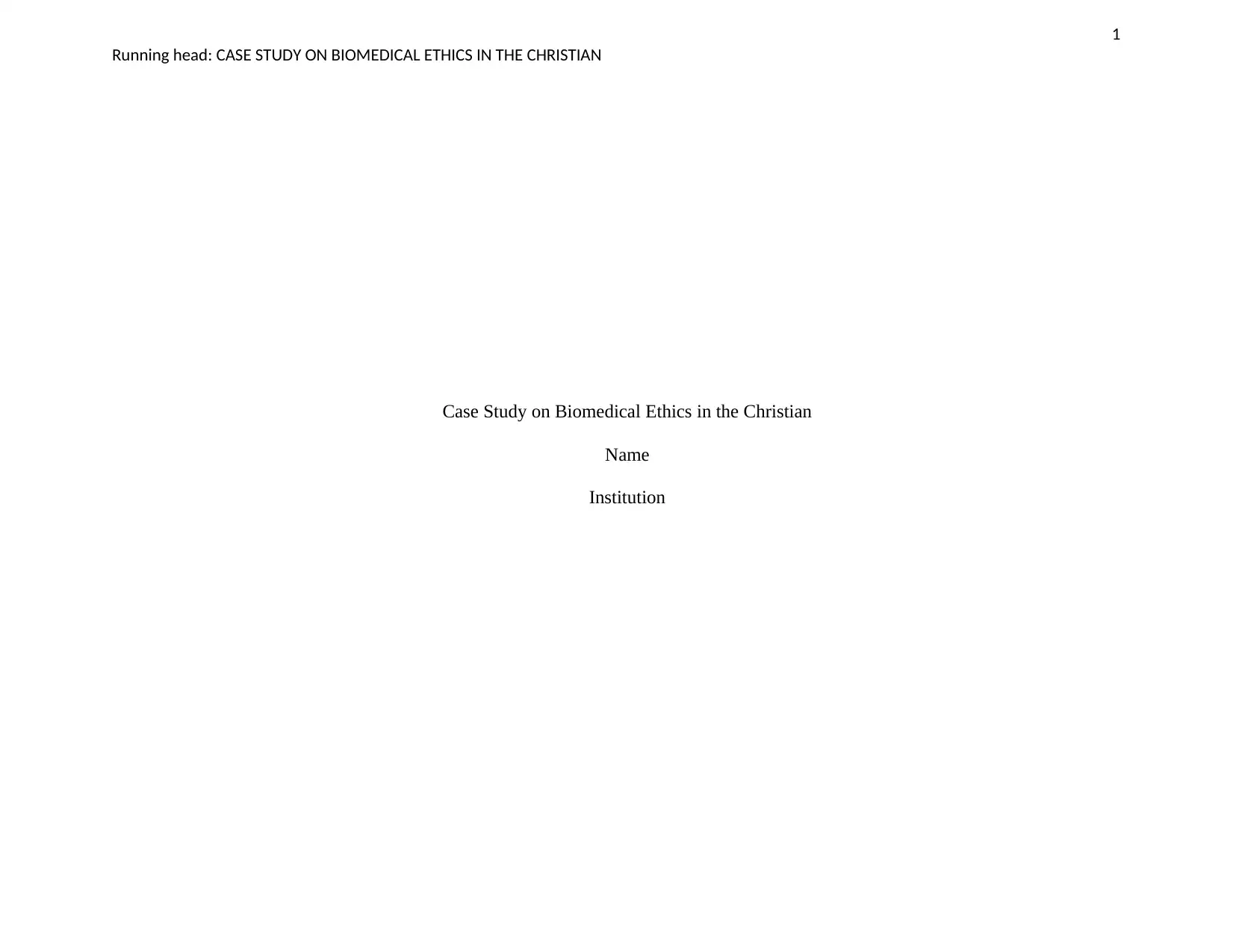
1
Running head: CASE STUDY ON BIOMEDICAL ETHICS IN THE CHRISTIAN
Case Study on Biomedical Ethics in the Christian
Name
Institution
Running head: CASE STUDY ON BIOMEDICAL ETHICS IN THE CHRISTIAN
Case Study on Biomedical Ethics in the Christian
Name
Institution
Paraphrase This Document
Need a fresh take? Get an instant paraphrase of this document with our AI Paraphraser
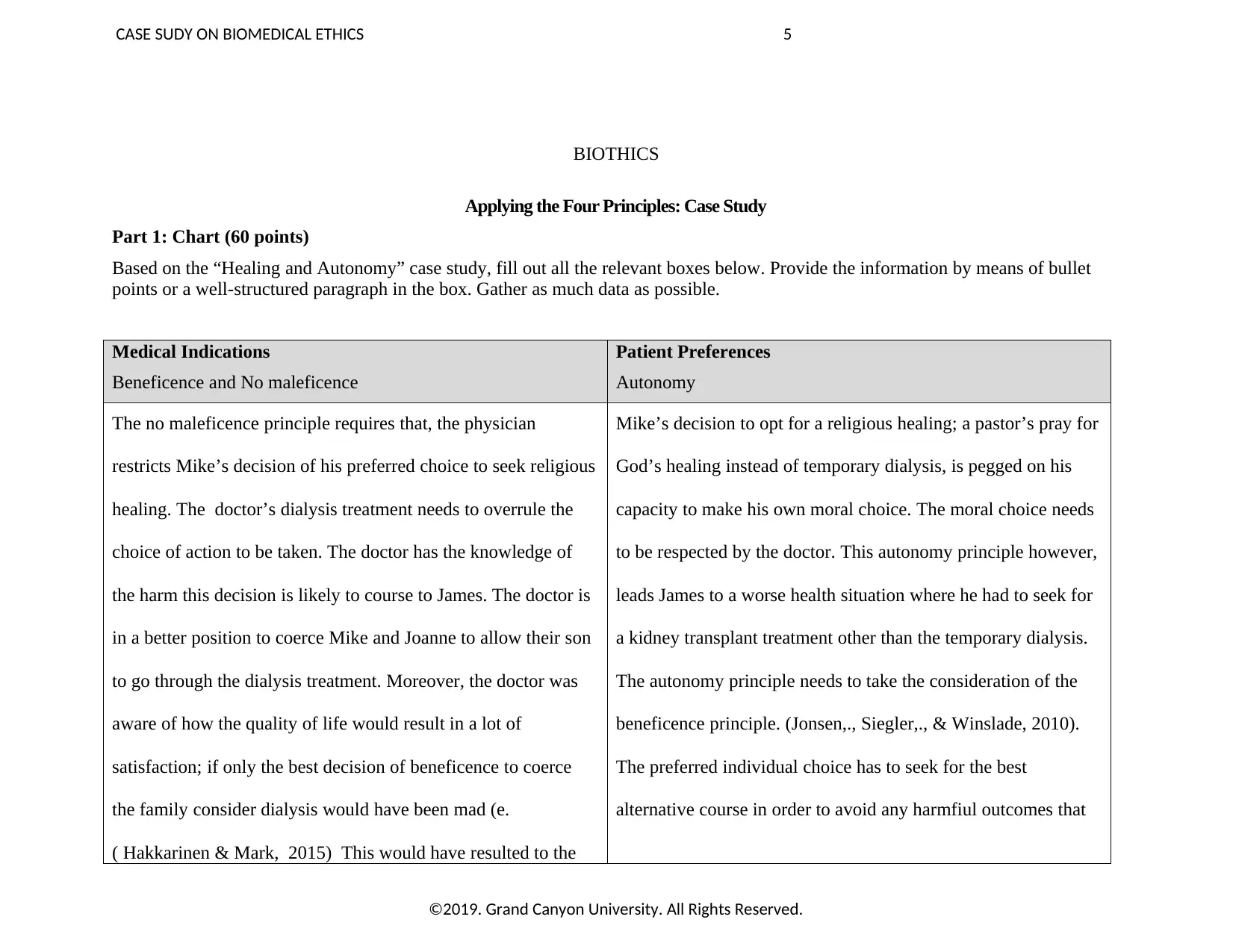
CASE SUDY ON BIOMEDICAL ETHICS 5
BIOTHICS
Applying the Four Principles: Case Study
Part 1: Chart (60 points)
Based on the “Healing and Autonomy” case study, fill out all the relevant boxes below. Provide the information by means of bullet
points or a well-structured paragraph in the box. Gather as much data as possible.
Medical Indications
Beneficence and No maleficence
Patient Preferences
Autonomy
The no maleficence principle requires that, the physician
restricts Mike’s decision of his preferred choice to seek religious
healing. The doctor’s dialysis treatment needs to overrule the
choice of action to be taken. The doctor has the knowledge of
the harm this decision is likely to course to James. The doctor is
in a better position to coerce Mike and Joanne to allow their son
to go through the dialysis treatment. Moreover, the doctor was
aware of how the quality of life would result in a lot of
satisfaction; if only the best decision of beneficence to coerce
the family consider dialysis would have been mad (e.
( Hakkarinen & Mark, 2015) This would have resulted to the
Mike’s decision to opt for a religious healing; a pastor’s pray for
God’s healing instead of temporary dialysis, is pegged on his
capacity to make his own moral choice. The moral choice needs
to be respected by the doctor. This autonomy principle however,
leads James to a worse health situation where he had to seek for
a kidney transplant treatment other than the temporary dialysis.
The autonomy principle needs to take the consideration of the
beneficence principle. (Jonsen,., Siegler,., & Winslade, 2010).
The preferred individual choice has to seek for the best
alternative course in order to avoid any harmfiul outcomes that
©2019. Grand Canyon University. All Rights Reserved.
BIOTHICS
Applying the Four Principles: Case Study
Part 1: Chart (60 points)
Based on the “Healing and Autonomy” case study, fill out all the relevant boxes below. Provide the information by means of bullet
points or a well-structured paragraph in the box. Gather as much data as possible.
Medical Indications
Beneficence and No maleficence
Patient Preferences
Autonomy
The no maleficence principle requires that, the physician
restricts Mike’s decision of his preferred choice to seek religious
healing. The doctor’s dialysis treatment needs to overrule the
choice of action to be taken. The doctor has the knowledge of
the harm this decision is likely to course to James. The doctor is
in a better position to coerce Mike and Joanne to allow their son
to go through the dialysis treatment. Moreover, the doctor was
aware of how the quality of life would result in a lot of
satisfaction; if only the best decision of beneficence to coerce
the family consider dialysis would have been mad (e.
( Hakkarinen & Mark, 2015) This would have resulted to the
Mike’s decision to opt for a religious healing; a pastor’s pray for
God’s healing instead of temporary dialysis, is pegged on his
capacity to make his own moral choice. The moral choice needs
to be respected by the doctor. This autonomy principle however,
leads James to a worse health situation where he had to seek for
a kidney transplant treatment other than the temporary dialysis.
The autonomy principle needs to take the consideration of the
beneficence principle. (Jonsen,., Siegler,., & Winslade, 2010).
The preferred individual choice has to seek for the best
alternative course in order to avoid any harmfiul outcomes that
©2019. Grand Canyon University. All Rights Reserved.
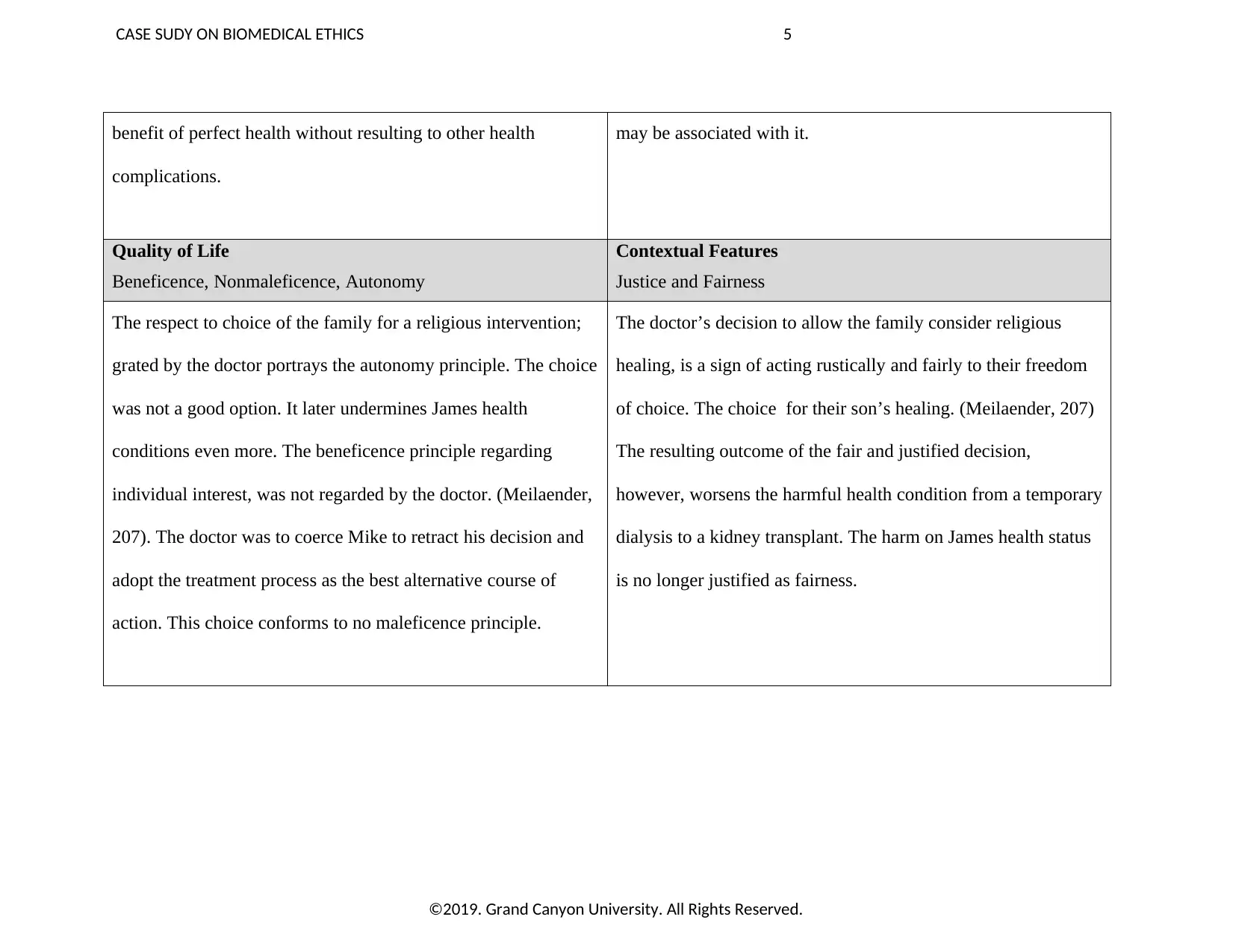
CASE SUDY ON BIOMEDICAL ETHICS 5
benefit of perfect health without resulting to other health
complications.
may be associated with it.
Quality of Life
Beneficence, Nonmaleficence, Autonomy
Contextual Features
Justice and Fairness
The respect to choice of the family for a religious intervention;
grated by the doctor portrays the autonomy principle. The choice
was not a good option. It later undermines James health
conditions even more. The beneficence principle regarding
individual interest, was not regarded by the doctor. (Meilaender,
207). The doctor was to coerce Mike to retract his decision and
adopt the treatment process as the best alternative course of
action. This choice conforms to no maleficence principle.
The doctor’s decision to allow the family consider religious
healing, is a sign of acting rustically and fairly to their freedom
of choice. The choice for their son’s healing. (Meilaender, 207)
The resulting outcome of the fair and justified decision,
however, worsens the harmful health condition from a temporary
dialysis to a kidney transplant. The harm on James health status
is no longer justified as fairness.
©2019. Grand Canyon University. All Rights Reserved.
benefit of perfect health without resulting to other health
complications.
may be associated with it.
Quality of Life
Beneficence, Nonmaleficence, Autonomy
Contextual Features
Justice and Fairness
The respect to choice of the family for a religious intervention;
grated by the doctor portrays the autonomy principle. The choice
was not a good option. It later undermines James health
conditions even more. The beneficence principle regarding
individual interest, was not regarded by the doctor. (Meilaender,
207). The doctor was to coerce Mike to retract his decision and
adopt the treatment process as the best alternative course of
action. This choice conforms to no maleficence principle.
The doctor’s decision to allow the family consider religious
healing, is a sign of acting rustically and fairly to their freedom
of choice. The choice for their son’s healing. (Meilaender, 207)
The resulting outcome of the fair and justified decision,
however, worsens the harmful health condition from a temporary
dialysis to a kidney transplant. The harm on James health status
is no longer justified as fairness.
©2019. Grand Canyon University. All Rights Reserved.
⊘ This is a preview!⊘
Do you want full access?
Subscribe today to unlock all pages.

Trusted by 1+ million students worldwide
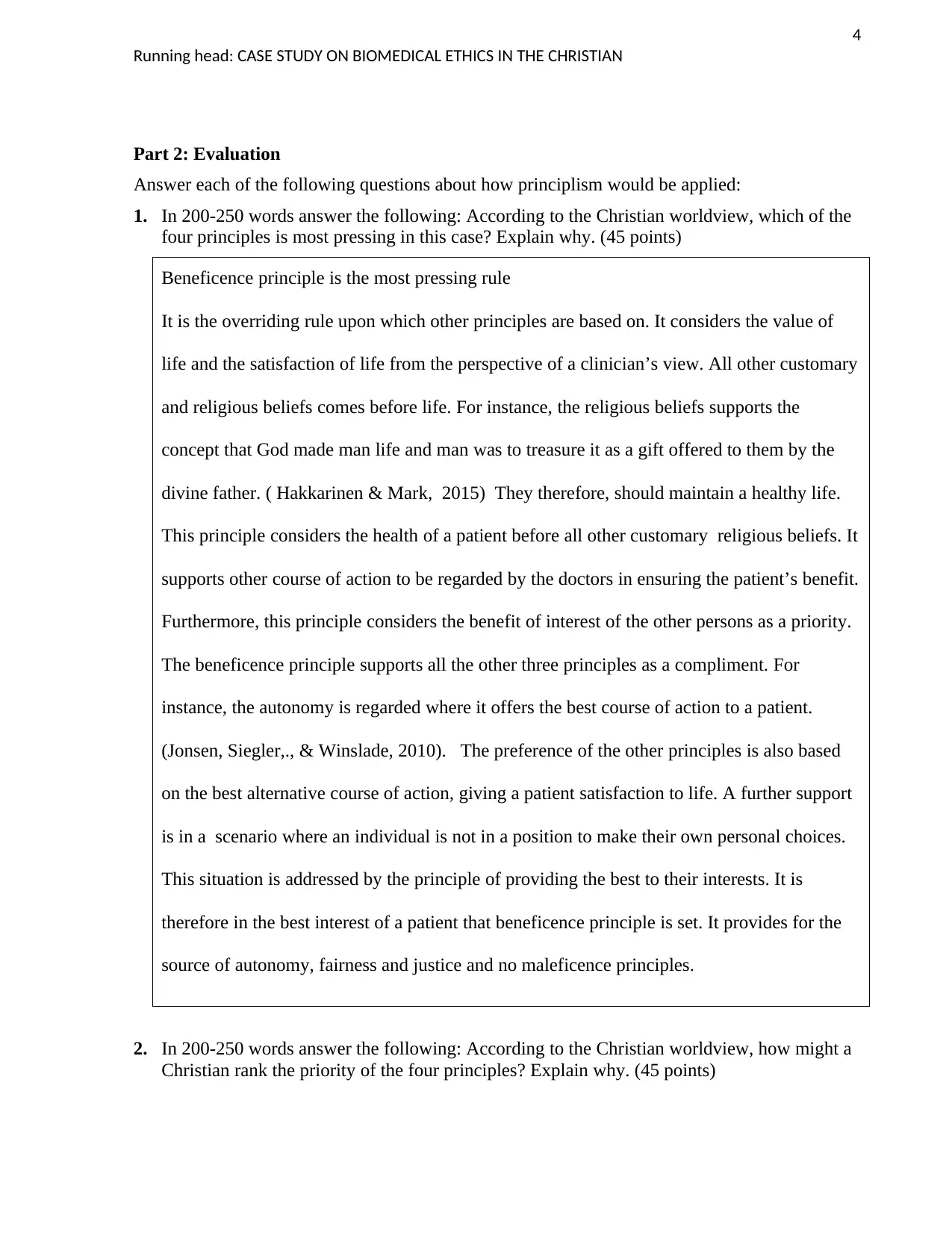
4
Running head: CASE STUDY ON BIOMEDICAL ETHICS IN THE CHRISTIAN
Part 2: Evaluation
Answer each of the following questions about how principlism would be applied:
1. In 200-250 words answer the following: According to the Christian worldview, which of the
four principles is most pressing in this case? Explain why. (45 points)
Beneficence principle is the most pressing rule
It is the overriding rule upon which other principles are based on. It considers the value of
life and the satisfaction of life from the perspective of a clinician’s view. All other customary
and religious beliefs comes before life. For instance, the religious beliefs supports the
concept that God made man life and man was to treasure it as a gift offered to them by the
divine father. ( Hakkarinen & Mark, 2015) They therefore, should maintain a healthy life.
This principle considers the health of a patient before all other customary religious beliefs. It
supports other course of action to be regarded by the doctors in ensuring the patient’s benefit.
Furthermore, this principle considers the benefit of interest of the other persons as a priority.
The beneficence principle supports all the other three principles as a compliment. For
instance, the autonomy is regarded where it offers the best course of action to a patient.
(Jonsen, Siegler,., & Winslade, 2010). The preference of the other principles is also based
on the best alternative course of action, giving a patient satisfaction to life. A further support
is in a scenario where an individual is not in a position to make their own personal choices.
This situation is addressed by the principle of providing the best to their interests. It is
therefore in the best interest of a patient that beneficence principle is set. It provides for the
source of autonomy, fairness and justice and no maleficence principles.
2. In 200-250 words answer the following: According to the Christian worldview, how might a
Christian rank the priority of the four principles? Explain why. (45 points)
Running head: CASE STUDY ON BIOMEDICAL ETHICS IN THE CHRISTIAN
Part 2: Evaluation
Answer each of the following questions about how principlism would be applied:
1. In 200-250 words answer the following: According to the Christian worldview, which of the
four principles is most pressing in this case? Explain why. (45 points)
Beneficence principle is the most pressing rule
It is the overriding rule upon which other principles are based on. It considers the value of
life and the satisfaction of life from the perspective of a clinician’s view. All other customary
and religious beliefs comes before life. For instance, the religious beliefs supports the
concept that God made man life and man was to treasure it as a gift offered to them by the
divine father. ( Hakkarinen & Mark, 2015) They therefore, should maintain a healthy life.
This principle considers the health of a patient before all other customary religious beliefs. It
supports other course of action to be regarded by the doctors in ensuring the patient’s benefit.
Furthermore, this principle considers the benefit of interest of the other persons as a priority.
The beneficence principle supports all the other three principles as a compliment. For
instance, the autonomy is regarded where it offers the best course of action to a patient.
(Jonsen, Siegler,., & Winslade, 2010). The preference of the other principles is also based
on the best alternative course of action, giving a patient satisfaction to life. A further support
is in a scenario where an individual is not in a position to make their own personal choices.
This situation is addressed by the principle of providing the best to their interests. It is
therefore in the best interest of a patient that beneficence principle is set. It provides for the
source of autonomy, fairness and justice and no maleficence principles.
2. In 200-250 words answer the following: According to the Christian worldview, how might a
Christian rank the priority of the four principles? Explain why. (45 points)
Paraphrase This Document
Need a fresh take? Get an instant paraphrase of this document with our AI Paraphraser
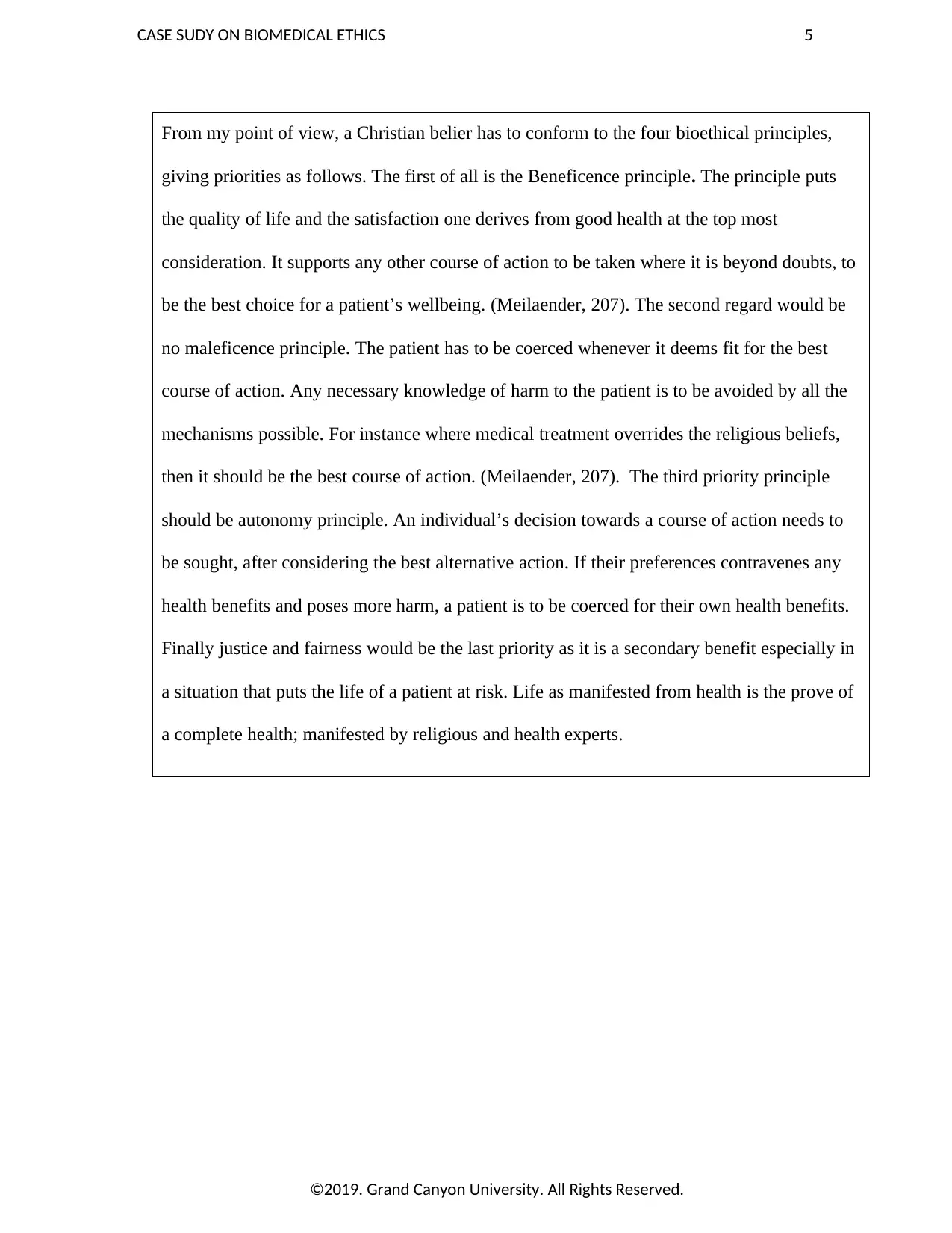
CASE SUDY ON BIOMEDICAL ETHICS 5
From my point of view, a Christian belier has to conform to the four bioethical principles,
giving priorities as follows. The first of all is the Beneficence principle. The principle puts
the quality of life and the satisfaction one derives from good health at the top most
consideration. It supports any other course of action to be taken where it is beyond doubts, to
be the best choice for a patient’s wellbeing. (Meilaender, 207). The second regard would be
no maleficence principle. The patient has to be coerced whenever it deems fit for the best
course of action. Any necessary knowledge of harm to the patient is to be avoided by all the
mechanisms possible. For instance where medical treatment overrides the religious beliefs,
then it should be the best course of action. (Meilaender, 207). The third priority principle
should be autonomy principle. An individual’s decision towards a course of action needs to
be sought, after considering the best alternative action. If their preferences contravenes any
health benefits and poses more harm, a patient is to be coerced for their own health benefits.
Finally justice and fairness would be the last priority as it is a secondary benefit especially in
a situation that puts the life of a patient at risk. Life as manifested from health is the prove of
a complete health; manifested by religious and health experts.
©2019. Grand Canyon University. All Rights Reserved.
From my point of view, a Christian belier has to conform to the four bioethical principles,
giving priorities as follows. The first of all is the Beneficence principle. The principle puts
the quality of life and the satisfaction one derives from good health at the top most
consideration. It supports any other course of action to be taken where it is beyond doubts, to
be the best choice for a patient’s wellbeing. (Meilaender, 207). The second regard would be
no maleficence principle. The patient has to be coerced whenever it deems fit for the best
course of action. Any necessary knowledge of harm to the patient is to be avoided by all the
mechanisms possible. For instance where medical treatment overrides the religious beliefs,
then it should be the best course of action. (Meilaender, 207). The third priority principle
should be autonomy principle. An individual’s decision towards a course of action needs to
be sought, after considering the best alternative action. If their preferences contravenes any
health benefits and poses more harm, a patient is to be coerced for their own health benefits.
Finally justice and fairness would be the last priority as it is a secondary benefit especially in
a situation that puts the life of a patient at risk. Life as manifested from health is the prove of
a complete health; manifested by religious and health experts.
©2019. Grand Canyon University. All Rights Reserved.
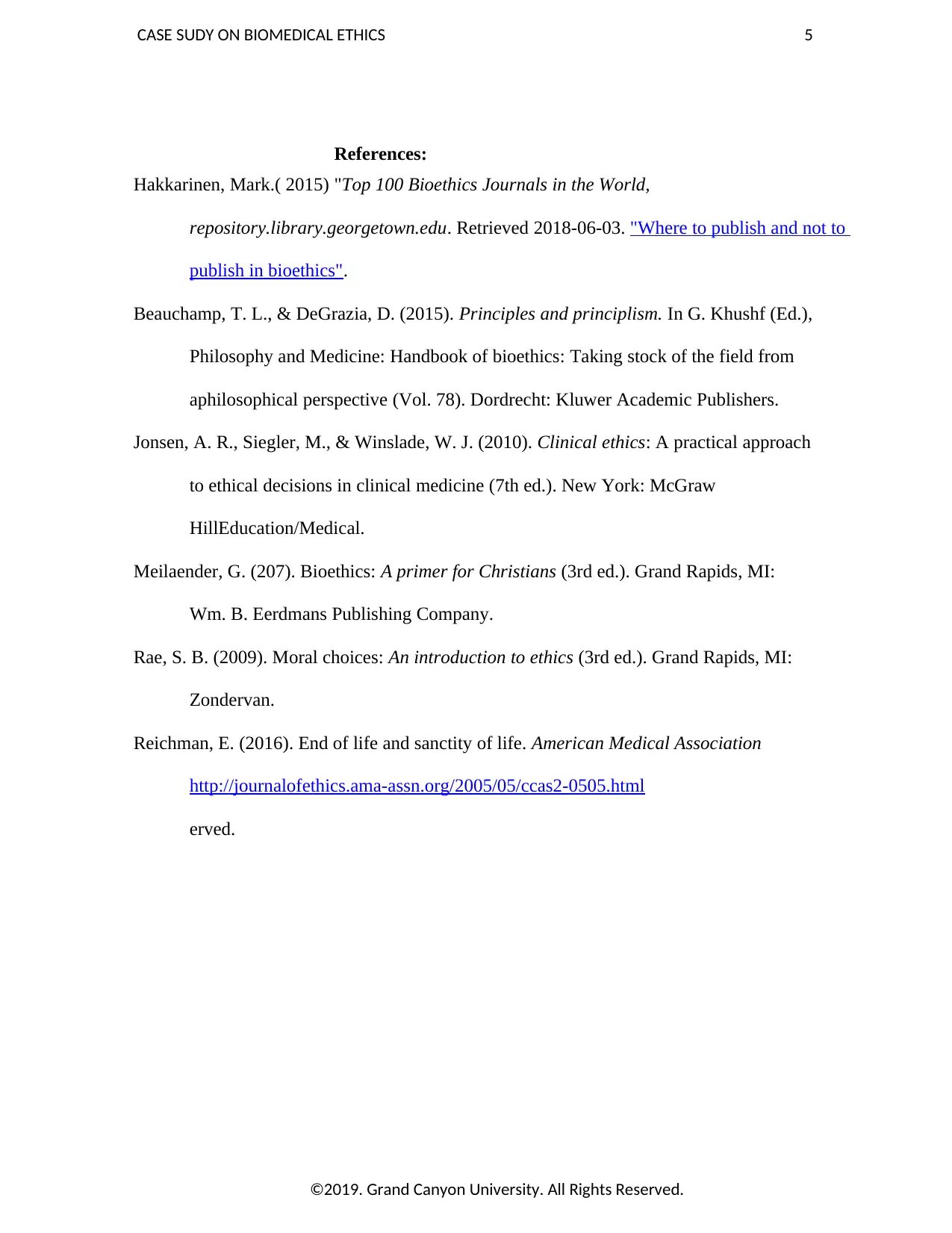
CASE SUDY ON BIOMEDICAL ETHICS 5
References:
Hakkarinen, Mark.( 2015) "Top 100 Bioethics Journals in the World,
repository.library.georgetown.edu. Retrieved 2018-06-03. "Where to publish and not to
publish in bioethics".
Beauchamp, T. L., & DeGrazia, D. (2015). Principles and principlism. In G. Khushf (Ed.),
Philosophy and Medicine: Handbook of bioethics: Taking stock of the field from
aphilosophical perspective (Vol. 78). Dordrecht: Kluwer Academic Publishers.
Jonsen, A. R., Siegler, M., & Winslade, W. J. (2010). Clinical ethics: A practical approach
to ethical decisions in clinical medicine (7th ed.). New York: McGraw
HillEducation/Medical.
Meilaender, G. (207). Bioethics: A primer for Christians (3rd ed.). Grand Rapids, MI:
Wm. B. Eerdmans Publishing Company.
Rae, S. B. (2009). Moral choices: An introduction to ethics (3rd ed.). Grand Rapids, MI:
Zondervan.
Reichman, E. (2016). End of life and sanctity of life. American Medical Association
http://journalofethics.ama-assn.org/2005/05/ccas2-0505.html
erved.
©2019. Grand Canyon University. All Rights Reserved.
References:
Hakkarinen, Mark.( 2015) "Top 100 Bioethics Journals in the World,
repository.library.georgetown.edu. Retrieved 2018-06-03. "Where to publish and not to
publish in bioethics".
Beauchamp, T. L., & DeGrazia, D. (2015). Principles and principlism. In G. Khushf (Ed.),
Philosophy and Medicine: Handbook of bioethics: Taking stock of the field from
aphilosophical perspective (Vol. 78). Dordrecht: Kluwer Academic Publishers.
Jonsen, A. R., Siegler, M., & Winslade, W. J. (2010). Clinical ethics: A practical approach
to ethical decisions in clinical medicine (7th ed.). New York: McGraw
HillEducation/Medical.
Meilaender, G. (207). Bioethics: A primer for Christians (3rd ed.). Grand Rapids, MI:
Wm. B. Eerdmans Publishing Company.
Rae, S. B. (2009). Moral choices: An introduction to ethics (3rd ed.). Grand Rapids, MI:
Zondervan.
Reichman, E. (2016). End of life and sanctity of life. American Medical Association
http://journalofethics.ama-assn.org/2005/05/ccas2-0505.html
erved.
©2019. Grand Canyon University. All Rights Reserved.
⊘ This is a preview!⊘
Do you want full access?
Subscribe today to unlock all pages.

Trusted by 1+ million students worldwide
1 out of 6
Related Documents
Your All-in-One AI-Powered Toolkit for Academic Success.
+13062052269
info@desklib.com
Available 24*7 on WhatsApp / Email
![[object Object]](/_next/static/media/star-bottom.7253800d.svg)
Unlock your academic potential
Copyright © 2020–2025 A2Z Services. All Rights Reserved. Developed and managed by ZUCOL.





